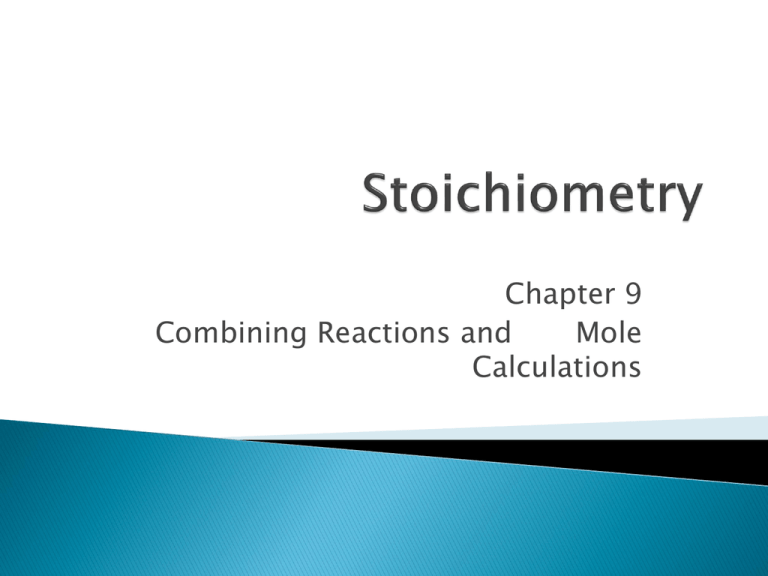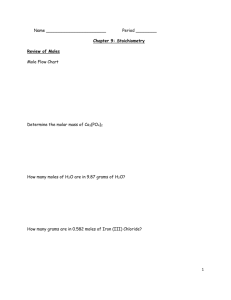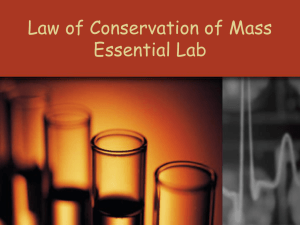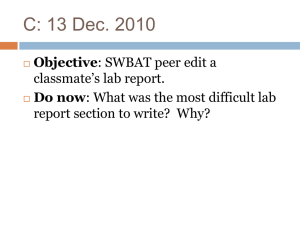1 - Cathedral High School
advertisement

Chapter 9 Combining Reactions and Mole Calculations When you know the quantity of one substance in a reaction, you can calculate the quantity of any other substance consumed or created in a reaction. Quantities are usually measured in grams or moles, but can also be expressed in liters, molecules, formula units, or atoms. Stoichiometry – calculation of quantities in chemical reactions. Calculations using balanced equations are called stoichiometric calculations. 1 N2 + 3 H2 → 2 NH3 The coefficients in the balanced equation indicate the moles of each reactant or product. You can use these coefficients to convert between different substances. 1 N2 + 3 H2 → 2 NH3 Total moles of reactants are not necessarily equal to total moles of products. Mass of individual reactants or products are not equivalent to each other, even though the total mass of reactants and products are equal. Mole-Mole Calculations 1 N2 + 3 H2 → 2 NH3 How many moles of nitrogen will react with 1.25 moles of hydrogen? Mole-Mole Calculations 1 N2 + 3 H2 → 2 NH3 How many moles of ammonia will be produced from the reaction of 2.35 moles of nitrogen with excess hydrogen? Mole-Mole Calculations 1 N2 + 3 H2 → 2 NH3 How many moles of hydrogen does it take to produce 0.825 moles of ammonia? Mass-Mass Calculations You will start with grams of one substance and be asked for grams of another substance. These calculations can be done using two reactants, two products, or a reactant and a product. 1. 2. 3. Change grams of your given substance to moles using the molar mass of the given substance. Change moles of your given substance to moles of the unknown using the coefficients from the balanced equation. Change moles of your unknown substance to grams using molar mass of the unknown substance. Use the following equation to answer the questions below: 4 NH3 + 5 O2 → 4 NO + 6 H2O How many grams of water will be produced when 1.25 moles of NH3 reacts with excess O 2? Use the following equation to answer the questions below: 4 NH3 + 5 O2 → 4 NO + 6 H2O How many moles of O2 are needed to produce 32.6 grams of NO? Use the following equation to answer the questions below: 4 NH3 + 5 O2 → 4 NO + 6 H2O When 0.750 moles of NO are formed, how many grams of water would you also expect to be produced? Use the following equation to answer the questions below: 4 NH3 + 5 O2 → 4 NO + 6 H2O How many grams of NH3 are required to produce 10.0 grams of water? Grams to grams stoichiometry calculations can also be done using Avogadro’s # (1 mole = 6.02 x 1023 atoms, molecules, or formula units) or using molar volume (1 mol = 22.4 L at STP). To use 1 mol = 22.4 L, it must say “at STP” in the problem. The only difference between these calculations and grams to grams calculations is that the molar mass is replaced by Avogadro’s number, but you always still use 1 mole. 2 NaHCO3 →1 Na2CO3 + 1 CO2 + 1 H2O How many grams of CO2 gas will be produced when 5.5 x 1022 molecules of NaHCO3 decomposes? How many formula units of NaHCO3 are required to produce 0.507 moles of H2O? 2 NaHCO3 → 1 Na2CO3 + 1 CO2 + 1 H2O How many liters of CO2 gas will be produced when 52.5g of NaHCO3 decomposes at STP? At STP, how many molecules of H2O are produced along with 6.85 L of CO2 gas 2 NaHCO3 1 Na2CO3 + 1 CO2 + 1 H2O How many formula units of NaHCO3 are required to produce 7.25 x 1022 molecules of H2O? Limiting reagent or limiting reactant – substance in the reactants that limits how much of the product(s) can be made. The reactants will combine until one of the reactants is used up. The reaction will only continue if you add more of the reactant that was used up first. A limiting reactant problem will be similar to a mass-mass calculation. The difference is that you will be given amounts of two reactants. Usually you will be asked to determine how much of a product can be produced. If you do two mass-mass calculations you can determine which reactant is limiting and how much of the product is produced. The reactant that produces the smallest amount of product is the limiting reactant. The amount of product formed from the limiting reactant tells you the most product that can be made. You can also find out how much of the excess reactant remains once the reaction stops. Excess reactant – substance that is left after the reaction has stopped. 1 N2 + 3 H2 2 NH3 How many grams of NH3 will be produced when 40.0 grams of N2 and 10.0 grams of H2 react? What is the limiting reactant? What is the excess reactant? 3Ba(OH)2 + 2Cr(NO3)3 2Cr(OH)3+ 3Ba(NO3)2 When 75 g Ba(OH)2 reacts 25 g Cr(NO3)3 how many grams of Ba(NO3)2 could be produced? What is the limiting reactant? What is the excess reactant? Calculating Percent Yield When doing any experiment it is easy for something wrong to happen. It is unlikely for anyone to do an experiment where there are no errors. When you go through a mass-mass (or grams to grams) calculation the value you determine is the theoretical yield. Theoretical Yield – maximum amount of product that could be formed from the amounts of reactants given in the problem. Actual Yield – amount that actually forms as a result of conducting a laboratory experiment. Percent Yield – ratio of the actual yield to the theoretical yield times 100. Percent Yield = Actual Yield x 100 Theoretical Yield Reasons not to get 100% Yield Reactions do not always go to completion Impure reactants Side reactions or competing reactions Loss of product during filtration or in transferring between different containers. Not heated long enough to remove all water. 2 Al + 3 CuSO4 1 Al2(SO4)3 + 3 Cu What is the percent yield of copper if 4.65 g of copper is actually produced when 1.87 g of aluminum reacts with an excess of copper (II) sulfate? What is the percent yield if 20.0 grams of copper (II) sulfate produces an actual yield of 12.5 grams yield of aluminum sulfate? 2 Al + 3 CuSO4 1 Al2(SO4)3 + 3 Cu What is the percent yield of copper if 4.65 g of copper is actually produced when 1.87 g of aluminum reacts with an excess of copper (II) sulfate? 2 Al + 3 CuSO4 1 Al2(SO4)3 + 3 Cu What is the percent yield if 20.0 grams of copper (II) sulfate produces an actual yield of 12.5 grams yield of aluminum sulfate? Solvents and Solutes Aqueous solutions – water samples containing dissolved substances. Solvent – substance doing the dissolving. 99% of the time water is the solvent. If it does not tell you what the solvent is, assume it is water. Solute – substance being dissolved. Molarity Concentration – measure of the amount of solute that is dissolved in a given quantity of solvent. Dilute solution – contains a low concentration of solute. Concentrated solution – contains a high concentration of solute. Molarity (M) – moles of solute per liter of solution. M is usually read as “molar”. Example: 12 M HCl would read as 12 molar hydrochloric acid. The volume of the solution is the total volume, not just the volume of the solvent. What is the molarity of a solution that contains 0.175 mol NaCl in 0.500 L of solution? What is the molarity of a solution that contains 25.0 grams of NaOH in 100. mL of solution? How many grams of Mg(NO3)2 are there in 250 mL of a 0.100 M Mg(NO3)2 solution? How many grams of Mg(NO3)2? What is the volume, in mL, of a 0.100 M CuSO4 solution be that contains 58.5 g of CuSO4? Making Dilutions Dilutions are often done for acids to make them less dangerous to work with during labs. Most acids come in standard concentrations, differing for each acid. Dilutions can be made by adding more solvent to a solution. Dilutions equation: M1V1 = M2V2 A concentrated sulfuric acid solution has a molarity of 18.0 M H2SO4. How many milliliters of the concentrated acid would you need to make 250 mL of 3.0 M H2SO4? If I had 10.0 mL of 3.0 M KOH solution and wanted to dilute it to 0.50 M KOH, what would the new volume of the solution be? How much water did you add to the KOH? If given a molarity and volume of one solution, you can solve for moles and then use a balanced equation to go most anywhere else. If you are asked for the molarity of a solution at the end of your problem, get to moles of the solution in question and then divide by the volume that will be given to you. 3Ba(OH)2 + 2Cr(NO3)3 2Cr(OH)3+ 3Ba(NO3)2 How many grams of Ba(OH)2 are required to react with 25.0 mL of 0.250 M Cr(NO3)3? How many formula units of Cr(OH)3 could be produced when 50.0 mL of 1.0 M Ba(OH)2 reacts with excess Cr(NO3)3? 1 N2 + 3 H2 2 NH3 What is the molarity of a 100. mL NH3 solution that could be produced from the reaction of 35.0 L of N2 gas with excess H2 at STP? If you are to solve for the volume of a solution at the end, the molarity of the solution in question must be given to you. In this case, solve for moles and use the molarity and moles of solute to solve for volume of the solution. 1 C3H8(g) + 5 O2(g) 3 CO2(g) + 4 H2O(l) What volume of 0.750 M CO2(g) could be produced when 250. mL of 3.5 M O2 reacts with excess C3H8?








